Pay it forward
Early planning and advance payments gave this hospital a financial edge. And this thinking has given the owners of South Suburban Animal Hospital in Perrysburg, Ohio, the freedom to focus on medicine in a new way.
Ever hear the story about the associate who planned to buy out her practice owner? Well, this version turns out differently than you might expect. With Drs. Jeanne Eisenhour and Gary Holfinger, the buyout never happens. Instead, the two doctors get married and become co-owners of three practices. Then they build a stunning new facility, South Suburban Animal Hospital in Perrysburg, Ohio, and win a 2007 Veterinary Economics Hospital Design Competition Merit Award for best large hospital.
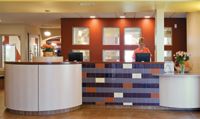
Reception: A greeter's station is bathed in natural light and gives clients a peek into the boarding and training area. Retail and educational displays surround the seating nooks. Dr. Jeanne Eisenhour particularly likes the bright yellow and purple and the high ceilings in this area.
Sometimes reality is even better than your best-laid plans, as this couple will attest—and they did a lot of planning for their new 10,597-square-foot small animal facility. The key, they say, is to refine your strategy so you know where you want to be 10 years down the road—and build for that future. "That's so basic, yet so important with this kind of investment," Dr. Holfinger says.
Preparing for the future
Drs. Eisenhour and Holfinger practice what they preach about planning ahead. Five years into their lease on a 2,800-square-foot facility, with the ink still wet on a second five-year deal, the doctors began planning for a larger, freestanding facility.
They found their ideal site, a lot that sat at the entrance to a new commercial development with three street frontages. One side of the hospital would face the main highway, bringing in tremendous traffic.
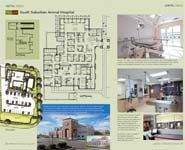
Hospital Design
The owners' timetable was intentionally long, and they used the time to pay off the real estate loan before they broke ground. Although the doctors also own two other practices that could have been leveraged to bankroll a new facility, they made a rule that South Suburban Animal Hospital would be self-sufficient. And that rule encouraged advance planning.
Knowing that they wanted to incorporate a new computer computer system into their paperless practice, the doctors purchased the system ahead of time. "We knew that moving in would be overwhelming enough for us and our staff members," Dr. Eisenhour says. So they bought the system a year in advance and trained the team on the new hardware and software. "Thank heavens we did!" she says. Of course, that was one more expense that the owners completely paid off before occupying the new facility.
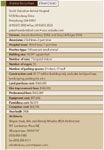
A look at the numbers
Free-flowing design
After working in a 2,800-square-foot leasehold, these doctors knew the perils of outgrowing their space too quickly. And their business protocol of discharging all clients from the exam rooms instead of the reception desk meant they'd need even more exam rooms.
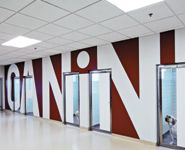
Boarding: A luxury boarding area surrounds the training and daycare room. The boldly colored word canine leaves no question as to which area of the hospital this is.
The basic plan for the new facility stemmed from a desire to include at least seven exam rooms, Dr. Eisenhour says. "We didn't go out and say we wanted a 10,000-square-foot hospital," she says. But once they added in the seven exam rooms and surrounding functions, they were at about 6,500 square feet. Boarding and grooming areas bumped the total to more than 10,000 square feet.
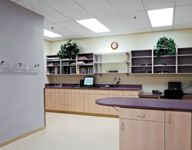
Pharmacy: From the central pharmacy, just outside the treatment and exam rooms, staff members have easy access to workstations and a library for quick reference.
A special procedures room also topped the list of must-haves for this duo. The doctors at South Suburban perform a lot of ultrasounds, and in the previous practice, they were forced to share space with radiology. Now they have a room to themselves. And the treatment room contained just two treatment tables before; now the doctors have five tables at their disposal.
Another feature that determined the practice layout was the idea of using a phone operator station and a greeter station instead of a traditional front desk. "Our first chance to build rapport with clients is during the initial phone call," Dr. Holfinger says. To make the best possible impression at this critical moment—and when the client first enters the practice—the doctors chose to build a separate room for phone business. This approach lets team members answering the phone and those greeting clients in person focus on their main duties.

Cat ward: The "catominiums" located just off of the reception and waiting areas keep both kids and adults content while waiting, and give the cats an entertaining view too.
Overcoming rigid restrictions
The exterior is Dr. Holfinger's favorite feature of the new facility. This is a a surprise, he says, because the exterior gave the two owners the most trouble—and increased building costs considerably. Both the city and the developers of the surrounding urban village set forth strict regulations about building exteriors. The developers were most concerned with the street frontages inside the development, forcing them to move the building closer to two streets, creating a continuous street frontage facing the development. This forced parking and the "front" facade to the back of the site, facing the main highway. In short, the owners were required to essentially have four front facades to appease all of the requirements.
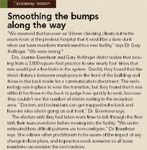
Takeaway lesson: Smoothing the bumps along the way
"While the building looks great, it also upped our costs considerably," says Dr. Holfinger. Restrictions mandated that all service and exercise areas be enclosed with solid garden walls topped with decorative wrought iron fencing. A colonnade trellis of columns wraps around the boarding and training wing that borders the entry drive from the development. Extensive landscaping requirements also boosted the cost, but ultimately helped give the hospital a striking appearance from every angle.
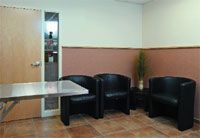
Exam: Seven standard exam rooms feature checkout capabilities, with computers in all rooms and cash drawers and credit card stations just outside. A service corridor allows all discharged patients to exit without having to go through the treatment area, which reduces congestion.
Just a year after opening, medical revenue is up between 5 percent and 10 percent per month. And with the addition of boarding, grooming, and doggy daycare, profits are up considerably too. In fact, ancillary services have been so successful they've picked up most of the slack between the former leasehold payments and the current bank note. Today, these doctors say they're thrilled; they can practice medicine the way they want to without worrying about the cost of owning their new building.
Sarah A. Moser is a freelance writer and editor in Olathe, Kan. Please send questions or comments to ve@advanstar.com